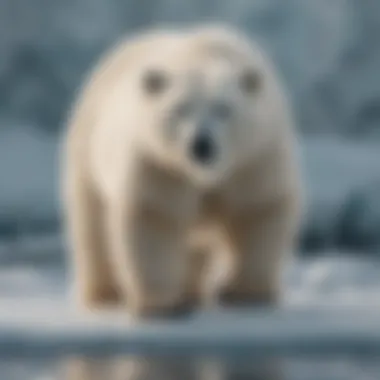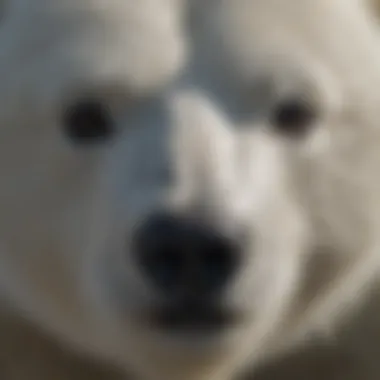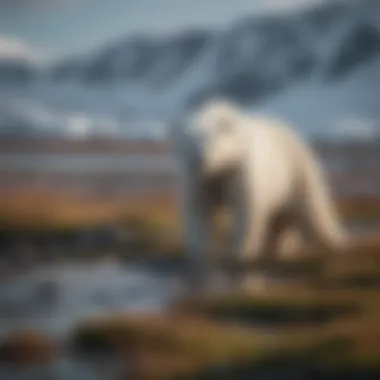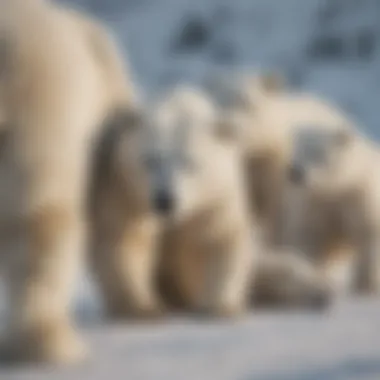Discovering Polar Bears: A Kid's Guide to Their Habitat


Nature Topic Overview
Polar bears are some of the most fascinating creatures on Earth. They roam the icy landscapes of the Arctic, where the cold defines their every aspect of life. This section is a gateway to understanding where these magnificent animals make their homes. Polar bears thrive on sea ice, primarily in locations like Alaska, Canada, Greenland, Norway, and Russia. It’s important to understand not only their geographical habitats but also the unique environmental conditions that allow these bears to exist and thrive. With the help of this guide, children will learn about the habitats of polar bears through detailed descriptions and engaging facts that spark curiosity and promote environmental awareness.
Fun Facts and Trivia
Did you know that polar bears have black skin under their thick white fur? The white fur helps them camouflage in their snowy surroundings, while the black skin absorbs heat from the sun. Here are more intriguing nuggets about polar bears:
- Polar bears are classified as marine mammals because they spend most of their life on the sea ice of the Arctic Ocean.
- An adult male polar bear can weigh between 900 and 1,600 pounds, roughly the size of a small car!
- Polar bears can swim for days at a time, covering distances of over 30 miles without stopping.
To make learning even more enjoyable, let's play a quick game! Try to spot the polar bear in these photos and see how well you can recognize their habitat.
Wildlife Explorations
In the Arctic, polar bears share their environmental space with a variety of other wildlife. For instance, walruses, seals, and Arctic foxes are some of the animals you might encounter. Each species has its own special adaptations that help them survive in this harsh climate. For example, seals have thick blubber that keeps them warm in frigid waters. You can learn about these other creatures and their habitats through fun educational puzzles or quizzes!
- Quiz Example: What animal has blubber to stay warm? A) Seal B) Caterpillar C) Squirrel
- Puzzle Challenge: Can you match the animal with its habitat? Try creating a chart!
Environmental Awareness
The Arctic is changing rapidly due to climate change, and this affects polar bears and their habitats. Melting ice caps threaten their hunting grounds, leading to struggles in finding food and even dangers of starvation. Kids can make a big difference, though! Here’s how:
- Conserve Energy: Turn off lights when not in use.
- Learn and Share: Read more about polar bears and tell friends about them.
- Support Conservation Efforts: Find ways to contribute to local wildlife charities that help polar bears and their environment.
"Every little action counts when it comes to protecting our planet!"
DIY Nature Activities
Getting hands-on can make learning more effective! Here are some fun activities that you can do at home or outside:
Create a Polar Bear Habitat Diorama
- Materials: Shoebox, cotton balls, blue paper, markers.
- Steps: Use the box as your base, glue cotton balls to represent snow, and use blue paper for water. Draw and place small paper polar bears in the diorama!
Nature Scavenger Hunt
- Grab a list of Arctic animals and go for a walk. Try to find pictures or copies of these animals in books, or look them up online.
These activities encourage creativity and reinforce learning about these magnificent creatures and the places they inhabit. Whether crafting a diorama or running around looking for wildlife pictures, children can truly connect with nature's wonders.
Understanding Polar Bears
Polar bears are fascinating creatures that roam the icy landscapes of the Arctic. Understanding these magnificent animals is not just a matter of curiosity; it plays a crucial role in conservation efforts and educational outreach. By learning about polar bears, children can develop empathy and a sense of responsibility towards wildlife and their natural habitats.
Polar bears are often referred to as marine mammals, as they spend most of their life on sea ice. This unique dependence on the ice makes them vulnerable to climate change, which is altering their environment at an alarming rate. Grasping the basic characteristics and behaviors of polar bears will help young readers become advocates for their protection.
Physical Characteristics of Polar Bears
Polar bears are the largest terrestrial carnivores on the planet. Standing tall, they can reach up to 10 feet when on their hind legs and weigh anywhere from 330 to 1,500 pounds! Their bodies are designed specifically for life in freezing temperatures. Here are some key physical traits that make them unique:


- Thick Fur: A polar bear's fur is not just white; it actually appears transparent and hollow, which helps reflect sunlight, providing insulation and allowing them to blend in with their snowy surroundings.
- Layer of Fat: Underneath their fur, polar bears have a thick layer of fat that can be up to 4.5 inches thick. This fat keeps them warm in icy waters.
- Large Paws: Their paws are about the size of a dinner plate, helping them to walk on thin ice and swim in the frigid waters of the Arctic.
- Powerful Swimmers: Polar bears can swim for days at a time, covering distances of more than 30 miles. Their strong limbs allow them to glide through the water with ease.
In summary, the physical characteristics of polar bears are well-adapted to their frigid environment. By knowing more about these features, kids can appreciate how nature equips animals with the necessary tools for survival.
Behavioral Traits
The way polar bears behave is just as interesting as their physical traits. Their behavior is largely influenced by the harsh conditions of their environment. Here are some fascinating aspects of polar bear behavior:
- Hunting Strategies: Polar bears primarily feed on seals. They are skilled hunters and often use a technique called "still-hunting." This involves waiting near a seal's breathing hole in the ice until the seal surfaces, making it a perfect moment to pounce.
- Territorial Nature: These bears can be quite territorial, especially males. They mark their territory with their scent and will engage in sparring matches with other males to assert dominance.
- Mother and Cub Bonding: A mother polar bear will take great care of her cubs, teaching them essential survival skills. These bonds are strong and can last for up to two years.
- Social Interactions: While polar bears are generally solitary, they can come together at places with abundant food, such as near seal hunting areas. Here, they may be seen sharing the space, albeit while maintaining their distance.
Understanding these behaviors helps kids realize the intricate social and environmental dynamics polar bears experience. By identifying with these admirable traits, young readers can foster a connection to wildlife and the importance of conserving their natural habitats.
"Every year, polar bears travel great distances in search of food and ice, showing resilience in their quest for survival."
Encouraging awareness about the lives of polar bears is a powerful way to inspire future generations to protect these incredible animals.
Natural Habitats of Polar Bears
Understanding where polar bears live is crucial for knowing how to protect them. These magnificent creatures primarily reside in regions that are cold and ice-covered, which are vital for their survival. The habitats provide not just a place to live but also the necessary resources for hunting and breeding. Without a proper understanding of their environments, it becomes difficult to plan effective conservation efforts.
Arctic Regions Overview
Polar bears are often dubbed the rulers of the Arctic. This vast and chilly expanse is their kingdom. The Arctic regions include areas from the northern coasts of Alaska and Canada to parts of Greenland and Russia. Here, the sea ice is essential to the lives of polar bears. They use it as a platform to hunt seals, their primary source of food. In recent decades, the ice has been melting earlier in the spring and forming later in the fall, disrupting the bears' hunting patterns.
"The Arctic is a harsh but beautiful environment where polar bears thrive, as long as the ice exists."
Coastal Areas of Alaska
In Alaska, coastal habitats provide unique environments for polar bears. Places like the northern coast, near Barrow and Prudhoe Bay, are hotspots for polar bear sightings. The ice-covered waters here allow bears to hunt seals. During the spring, as the ice begins to melt, these bears roam along the shores. Families often build dens in the snow along the coast, where mothers give birth to their cubs.
Some citizens of Alaska have traditional knowledge about bears and their migrations, which can inform conservation efforts. They know that fluctuations in temperature and ice formation play a big part in these magnificent animals’ lives.
Canadian Arctic Archipelago
Travel a little north, and you enter the Canadian Arctic Archipelago. This vast stretch is home to many polar bears, particularly on the islands. Locations like Baffin Island and Ellesmere Island are significant because of their rich marine life and ice floes. These islands provide extensive habitats where the bears can hunt seals effectively. However, here, like elsewhere, climate change poses threats to their natural habitats. The melting ice affects their ability to find food and raise cubs safely.
Greenland's Polar Bear Population
Greenland has a unique relationship with polar bears. The Greenlandic people coexist with bears, and their traditional ways of life often involve understanding bear patterns. Polar bears in Greenland tend to be on the move, following the shifting ice. The hunting season here is essential, because it allows locals to gather food while respecting the bears' habitats. The southern part of Greenland may have fewer bears, but the northern regions are filled with them, showcasing the need for careful observation and conservation efforts.
Svalbard: A Norway Destination
Svalbard is another prime location to spot polar bears. This archipelago is between Norway and the North Pole, and it has become a popular site for tourists and researchers alike. The bears can often be seen wandering across the islands or resting on the ice floes. Svalbard has strict regulations to protect polar bears, which creates a safer environment for them. Visitors coming to Svalbard can learn about polar bear conservation efforts, making it a perfect destination for those who wish to learn while exploring.
Chukotka Region in Russia
The Chukotka region in Russia is less known but equally important for polar bears. It's located just across the Bering Strait from Alaska. This area boasts vast stretches of ice and very few people. Bears here rely heavily on sea ice for movement and hunting. The cultural perspective of the indigenous people offers insights into how they live with and conserve bear populations. Knowledge about their habitats can help researchers understand bear behaviors and range.
Best Times to Spot Polar Bears
Polar bears are fascinating creatures, and knowing when to spot them can make your adventure unforgettable. Understanding the best times to see these beautiful animals allows budding adventurers to plan trips effectively, ensuring they catch sights of polar bears in their natural settings. This section dives into the seasonal migration patterns of polar bears and the optimal viewing months, painting a clearer picture for young explorers and their families.


Seasonal Migration Patterns
Polar bears are quite the wanderers! They follow the ice as it forms and melts throughout the year. In spring, as the ice melts away, the polar bears often migrate toward land. Here’s how their journey unfolds:
- In Spring, polar bears move to areas where the ice is stable, which usually happens in March and April. This is when they can hunt seals effectively, as seals also come to breathe at the holes in the ice.
- By Summer, there's a considerable reduction in ice, so many bears will head towards the coast or areas with shallow waters. They tend to drift in these areas, waiting for the ice to form again.
- Autumn brings migration back towards areas where ice covers the ocean. This transformation occurs often in September and October as the bears seek out hunting grounds.
- In Winter, when the ice has formed again, they return to the hunting grounds on the pack ice.
"Every time you see a polar bear, you're witnessing an amazing journey full of natural instincts!"
By understanding these migration paths, children can appreciate the traveling challenges these large mammals face. It’s not just about seeing them; it's about learning how these animals adapt to their environment.
Optimal Viewing Months
If you want a good chance of seeing polar bears, timing is crucial. While each season has its own charm, certain months stand out:
- March to April: As the bears venture out onto stable ice, they're typically still hunting. This is an excellent time to catch them in action!
- September and October: During these months, polar bears are often spotted as they prepare for the thickening ice and hunt for seals. Their activity levels increase, and you're more likely to observe them at this time.
Here’s a simplified take on these months:
- Best months to see polar bears: March, April, September, and October.
- These months provide the best chances for spotting and studying their behaviors as they hunt and play.
Knowing these optimal times can lead to an educational experience, helping young minds to connect with wildlife and the significance of polar bear conservation. Visitors must prepare accordingly to respect both these majestic creatures and their environments.
How to Safely Observe Polar Bears
When it comes to observing polar bears, safety is key. These magnificent creatures roam in some of the harshest environments on Earth, and understanding how to watch them without disrupting their natural behavior is essential. Safe observation helps protect both the bears and the viewers, ensuring that everyone has a rewarding experience without compromising wildlife integrity. By the end of this section, young readers will know how to venture into polar bear habitats responsibly, finding ways to appreciate their splendor without causing them any distress.
Guided Tours and Expeditions
Joining a guided tour or expedition is one of the best ways to see polar bears in their natural habitat. Specialized guides know the ins and outs of polar bear behavior and the safest viewing practices. Here are a few reasons why going with a guide is beneficial:
- Expert Knowledge: Guides are trained in polar bear behavior, leading to safer interactions.
- Safety Measures: They prepare you for the harsh conditions in polar regions, keeping you safe and warm.
- Respect for Nature: Guided tours emphasize responsible viewing, ensuring that polar bears remain undisturbed.
Many adventures take place in places like Churchill, Canada, which is known as the "Polar Bear Capital of the World." Here, tourists can witness these bears as they wait for the sea to freeze, making it easier for them to hunt for seals. Seeing a polar bear from a safe distance, especially through the lens of a camera, can be an exhilarating experience that creates lasting memories.
Do's and Don'ts for Wildlife Viewing
When observing polar bears, it's crucial for everyone, especially children, to remember some important do's and don'ts to make the experience safe and respectful:
Do's:
- Keep a Safe Distance: Always maintain a respectful distance. This ensures both your safety and the bear's comfort. A good rule is to stay at least 100 yards away.
- Use Binoculars or Cameras with Zoom: Bring binoculars or a camera with a zoom lens to get a closer look without encroaching on their space.
- Follow Your Guide's Instructions: They know best how to keep everyone safe around polar bears.
- Stay Quiet: Loud noises can startle the bears, which might cause them to act unpredictably.
Don'ts:
- Don't Approach Bears: Trying to get closer for a photo can endanger both yourself and the bear. It's crucial to remember that they are wild animals.
- Avoid Feeding Polar Bears: This may seem harmless, but feeding them can alter their natural behaviors and put both the bear and people in danger.
- Never Use Flash Photography: Blinding a polar bear with a flash can stress them out and lead to unintended situations.
"Respect for wildlife underpins the foundation of all great nature experiences. Treat animals as guests in their home."
By adhering to these guidelines, young observers can enjoy the adventure of seeing polar bears while ensuring their safety. Each moment spent watching these incredible animals in their own environment is a chance to appreciate the unique relationship we share with nature.


Conservation Efforts for Polar Bears
Polar bears face many challenges in their natural habitats due to the changing climate and human activities. Understanding the significance of conservation efforts is crucial for preserving these magnificent animals and their environments. As young readers learn about polar bears, it’s essential to also grasp why these efforts matter. Protecting polar bears doesn’t just help them; it ensures the delicate balance of their Arctic ecosystems, which impacts other species and our planet.
Understanding Climate Change
Climate change is one of the most serious threats to polar bears. The Arctic is warming at a faster rate than many other places on Earth. This leads to melting ice, which is critical for polar bears. They rely on sea ice as a platform for hunting seals, their main source of food. When the ice melts earlier in the spring and forms later in the fall, it shortens their hunting season.
- Key impacts of climate change include:
- Reduced ice habitat, causing difficulty in hunting.
- Changing prey availability, which affects bear diets.
- Increased encounters with humans as bears wander in search of food.
By understanding these changes, students can become advocates for reducing carbon footprints and supporting laws that mitigate climate impact.
International Agreements and Policies
Addressing the threats to polar bears requires cooperation across countries. There are several international agreements aimed at protecting these bears and their habitats. One significant pact is the Polar Bear Conservation Management Plan, developed by the five polar bear range states: Canada, Denmark (Greenland), Norway, Russia, and the United States. This agreement focuses on reducing human impacts and protecting critical habitats essential for polar bear populations.
Some key policy goals include:
- Monitoring populations to ensure they remain stable.
- Protecting key habitats from oil drilling and industrial activities.
- Educating the public about the importance of polar bears in the ecosystem.
These policies demonstrate how countries can work together to safeguard polar bears while balancing the needs of local communities.
Community Involvement and Awareness
Community engagement plays a pivotal role in conservation. Local communities, especially those living in regions inhabited by polar bears, are directly affected by changes in the polar environment. Involving them in conservation efforts can yield powerful results.
- Ways communities can get involved:
- Participating in local conservation programs that help protect polar bear habitats.
- Engaging in educational workshops to raise awareness about wildlife and ecosystem protection.
- Organizing clean-up drives to keep coastal areas free from pollution, which can end up harming marine wildlife.
"It takes a village to raise a child, and it takes a community to protect its surrounding wildlife."
By fostering community involvement, we can cultivate a sense of ownership and responsibility toward polar bears, ensuring future generations can also admire these incredible creatures.
Interesting Facts about Polar Bears
Polar bears are truly captivating creatures, and understanding their fascinating characteristics can help us appreciate the grandeur of the natural world. Each unique fact not only sparks curiosity but also inspires a sense of duty towards conserving these majestic animals. When children learn about polar bears, it’s not just about where they live—it's about what makes them special, and why we should all care for their habitats.
Unique Adaptations to Cold Environments
Polar bears have a range of adaptations that help them thrive in their icy homes. These adaptations enable them to maintain body warmth and hunt effectively despite harsh conditions. Here are some key features:
- Thick Blubber Layer: Polar bears are equipped with an impressive layer of fat under their skin, often up to 4 inches thick. This helps to insulate them from freezing temperatures and keeps them warm as they swim in frigid waters.
- Fur Coating: Their fur is not just for decoration. It consists of a soft undercoat and longer guard hairs that trap air, adding an extra insulating layer. Surprisingly, the fur appears white but is actually transparent, which helps them blend into their snowy surroundings.
- Large Paws: The paws of polar bears are wide and equipped with fur on the soles. This feature acts like natural snowshoes, preventing them from sinking into the snow while walking and helping them catch prey on ice.
"Adaptations of polar bears showcase nature's ingenuity in surviving extreme conditions. Understanding them can foster respect for wildlife."
By learning about these adaptations, young readers can grasp how evolution shapes each species perfectly for their environment.
Cultural Significance
Polar bears hold a prominent place in various cultures, particularly among Arctic indigenous peoples. These wide-ranging traditions reflect deep respect and connection with nature:
- Symbol of Strength: In many cultures, polar bears are seen as symbols of strength and endurance. Stories and legends often depict them as heroes of the Arctic, embodying qualities that are revered by the community.
- Art and Tradition: For example, the Inuit people have woven the image of the polar bear into their art, crafts, and folklore. The bear appears in their storytelling and visual expressions, serving as a reminder of the resilience required to thrive in the Arctic climate.
- Environmental Advocacy: Modern-day conservation efforts also use polar bears as a focal point in environmental education. They symbolize the plight of many species affected by climate change. Understanding their cultural relevance can encourage kids to become more environmentally conscious and advocates for wildlife protection.
Through these interesting facts and cultural connections, children can develop a deeper understanding of polar bears—not just as animals, but as vital symbols tied to human history and the health of our planet.







